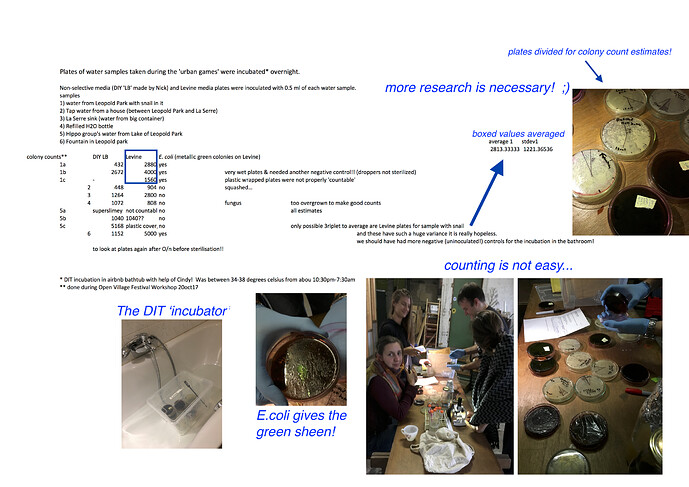Thank you for the questions and comments.
Indeed when ‘printing’ a page from excel it is always hard to interpret how the columns fit together with labels.
I will add a box or something to help clarify what is what and attach it next…
In terms of the hopes for reliable numbers from the plate counts a bit of background might help for people who did not make it to the presentation or at least see the prezi (which is open access here: Citizen Science by Rachel Aronoff).
Basically, for environmental microbial sampling, the rule is to take 3 independent samples from each site, then at the minimum you will have 3 plates to count colonies on (even better would be to have min 3 plates per sample). 0.5ml of water is put on each plate, spread over the surface (using sterile technique) then allowed to grow. (In the end all the values are calculated to know the average number of original cells in 100ml of a given sample.)
Then, the other important thing to grasp is that each microbial colony seen the next day on the plates (containing millions of cells after the overnight growth) represents of a single original cell from the sample, that has replicated in a certain spot of the plate - we call these ‘colony forming units’ because it is likely that there are lots of cells that actually don’t make colonies (because they don’t like the nutrients or the temperature or other parameters…). In fact the purple ‘Levine plates’ contain bile salts that prevent a whole class of abundant bacteria from growing (gram+ ones, if this means anything to you). This helps us look for ones of interest, esp our ‘bioindicator’ for untreated sewage, E. coli, which allows us to think that tons of other unknown things (enteroviruses, micropollutants) are also probably in the sampled water.
Of course, very importantly, one can’t just sample without comparing to something or another, and generally there is always a positive control (here in Switzerland, we have used river water or even sometimes toilet water - I still meant to talk with the other Alberto more about how rivers are full of bugs… ![]() sadly…) and a negative control, ordinarily tap water.
sadly…) and a negative control, ordinarily tap water.
Finally, you need to have confidence that your plates themselves are not going to just randomly have lots of things growing - an uninoculated control! This was something we really lacked last week! With the plates just freshly poured at La Serre, there were many possibilities for sources of contam, like the droppers we used to inoculate the plates with the water samples. Finally, the plates normally should have some time to lose excess water, otherwise the colonies can be smeary and very hard to distinguish one from another…
One other variable is the treatment of the sample. Ordinarily the rule is, after sampling, the tube must be kept in the cold and plated within 5 hours. Our tubes, perhaps, were not entirely sterile, and they were just carried around and left until we did the plating after dinner…
Ask more questions if this is not clear.
I will put an image up showing a collection of plates from one of our sampling days this last summer. (we had another special plate, termed ‘chromogenic’ that allows one to distinguish at least 4 kinds of bacteria, and even a fluorescent substrate that confirms E.coli - pics of this are in the prezi…)
Then, as you say, we ultimately want counts that give numbers that we can use for statistical tests, like the T-test…
For these tests though, you need at least 3 samples averaged to compare.
However, we only had one set of 3 plates with counts, and their variance was so high, not much could be said, esp without an average of 3 from controls to compare against!
Counting more than once is another good option, and we could have attempted that - actually we still could using some pictures! But, because of the problem of the negative controls full of colonies (but at least not E. coli), we would still have a very difficult time drawing meaningful conclusions. The crazy incubation in the bathtub also meant that the plates were not only super smeary, but a couple only had saran wrap as a cover, and got squashed! Also one could imagine bacteria floating on water droplets to cause all our negative controls to have so many colonies (if it wasn’t the droppers we used or the tubes we collected the samples in, which were left at RT too long…)!
Quantitative biology is coming of age now, I should note - tons of old papers that relied on stats p<0.05 are now realised to be completely underpowered and with non-reliable conclusions.
I am happy you asked some probing questions!
Have a great Sunday!!
Here is an example of plates from one week’s sampling last summer.
The positive controls have lots of colonies, the negative controls almost none, and the regional samples (from Lake Geneva around Montreux Bay) have varying amounts. To note, 0.5ml was put on the positive controls, and unknowns here had 4ml per plate inoculated. Again, in the end you make the numbers per 100ml (as in Alberto Rey’s Bagmati graphics…)!
Here is the summary I made already, with a few extra things:

